Settings/Events
Add a New Event
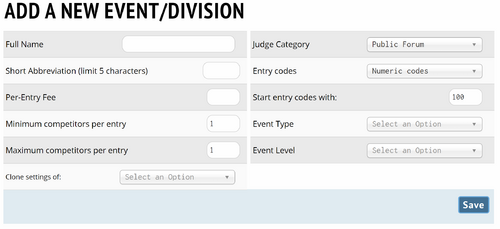
Full Name - Displayed name for the event
Short Abbreviation (limit 5 characters) - Abbreviation for the event that will appear in various tabroom screens.
Per-Entry Fee - Value charged to school for each entry in an event.
Minimum competitors per entry - The minimum number should almost always be 1 (for IE's and LD), 2 (for CX and PF), or 3 (for WSD). You could set it to 1 for a team event if you wanted to allow maverick entries.
Maximum competitors per entry - The maximum number is almost always 1 (for IE's and LD), 2 (for CX and PF), or 5 (for WSD). If you have a debate event that allows 3 or 4 person teams (for example novice policy in some states), you would use a higher number.
Clone settings of: - Will overwrite your current Event settings with the settings from the event you choose.
Judge Category - Judge group the event should pull judges from
Entry codes - Controls how entries will appear in registration lists and on schematics and ballots.
Starting codes - Numeric value to start the entry codes with for the event
Event Type - Set the type of event, for example Speech, Congress, Policy, LD, or PF.
Event Level - Choose between Open/Varsity, JV, Novice, etc. This will affect how certain result sets are computed, for example if you wanted to get a list of the best Novice participants across all events
NSDA Event Code - This allows you to choose the code for each event in your tournament. For example, if you are setting up Congress as an event, you would select the event code 'Congressional Debate' from this menu.
Debate Topic - This allows you to choose the topic for each debate event. The topic will display on judge ballots.
Main
Same as the Add New Event/Division Screen
Registration
Deadlines

New Entries Due - Deadline for schools to add new entries to an event.
Fee/Judge Freeze - Deadline when fees and judge obligations freeze regardless of changes to an entry after that date.
Fine on Drops After - Drops after this date will result in a fine to the school.
Event Specific Nuisance Fine for Drops - Sets the value of the fine for drops after a certain date.
Registration

Allow hybrid entries (2+ schools) - Toggle to allow hybrid entries to register for particular events.
Hide entry codes from registering coaches - Toggle to prevent showing registering schools the entry codes for each of their entries, to maintain a little extra anonymity.
Publish field report/entry list on web - Toggle to displays entries on the main Tabroom page for the tournament.
Include waitlist on field reports - Toggle to include waitlisted entries on public reports for specific events.
Supplemental Event - Toggle to mark the event as a "supplemental" event, usually considered one that doesn't count towards sweepstakes, or that students can participate in if they are not participating in the elimination rounds of their main event.
Caps & Waitlists
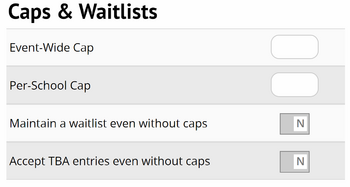
Event-Wide Cap - Value that sets the limit for how many total entries will be allowed in the given event.
Per-School Cap - Sets a limit on the number of entries any one school can have in the event.
Waitlist all entries - Toggle to have all entries added to a waitlist when registered.
No waitlist; schools are limited to caps only - Toggle to limit schools to register entries in the event based on caps (no waitlist is used at all).
Ask registrants to rank waitlist priorities - Toggle to let schools rank its entries in the event to help determine priorities for those entries getting off the waitlist.
Judging adjustments
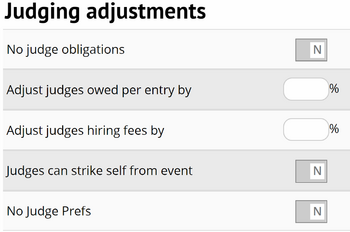
No judge obligations - Overrides other judging settings and doesn't require any obligated judging for entries in the event.
Adjust judges owed per entry by - Reduces or increases judge obligations per entry by a percentage from the value determined in Settings -> Judges.
Adjust judges hiring fees by - Reduces or increases hired judge fees by a percentage from the value determined in Settings -> Judges.
Judges can strike self from event - This allows judges to self-select that they don't want to judge an event. For example, can be useful to allow inexperienced judges to choose not to judge a "TOC qualifying" division.
Breakout Round Designations

Add a breakout/flag labeled - The initial box that allows you to add a breakout section to an event.
Breakout/Flag 1 Label - Displays the name of the breakout section you are creating.
Breakout 1 marked at registration by coach? - Toggle to allow coaches, during registration, to designate which of its competitors should be eligible for a breakout.
Exclude entries already in another elim? - Toggle to make sure entries that are in another elim round are not allowed to also compete in a breakout.
Qualifiers
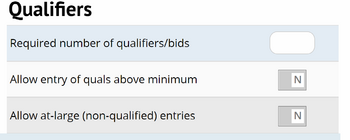
Required number of qualifiers/bids - If your tournament has an explicit bid qualification process, you can include the number required here.
Allow entry of quals above minimum - This allows schools to enter teams if they're qualfied (i.e. have more than the required number of bids), over the minimum.
Allow at-large (non-qualified) entries - This lets school's enter teams even if they're not qualified (i.e. they lack the required number of bids). Usually used in conjunction with the waitlist settings to clear "at-large" teams into the tournament at your discretion.
Online
Online Options

Not Online - Option to select if your event is in person.
NSDA Campus - Option to select NSDA Campus as the online hosting platform. These are typically used for any event that does not plan to allow observers.
NSDA Campus with Observers - Option to select NSDA Campus with Observers as the hosting platform. These are typically used for any event where you would like to allow a limited number of observers.
Asynchronous links to online videos - If checked, this will allow speech competitors to upload video links during registration and is only necessary when speech events are held asynchronously.
Synchronous via pre-created room URLs - If checked, you have chosen to host an event synchronously using pre-created rooms (like Zoom rooms).
Show room URLs on public schematic - Option to display links to room on public pairings.
Show async video links on judge ballots - Option to display links to videos on judge ballots.
Online/In Person Hybrid - Toggle if your event will allow online and in person participants.
Status screen: Track Entries not individuals - Toggle to allow tab staff to only track entries entering online rooms before a round begins. For example, in policy debate if one half of a partnership comes into an online room before a round start, that team would be considered present (rather than having to track each individual of the team).
Status screen: Poke only judges - Option that appears on the status screen and allows tab room staff to poke only judges if they have not shown to their competition room.
NSDA Campus Options

Event room usage limit - Option to set the limit on how many rooms you choose to use in any particular online event.
Prepend user role to name (Judge/Entry/Tab) - Option to determine the naming convention in NSDA Campus rooms.
Show entries in rooms by - Sets the default display for participants in NSDA Campus rooms.
Show judges in rooms by - Sets the default display for judges in NSDA Campus rooms.
Online Support Options

Support Email - Email given to participants to contact for support during the tournament.
Online Instructions - Instructions to participants that will display....
Apply contact/instructions to: - Option to display instructions to specific events or the entire tournament.
Pairing
Pairing
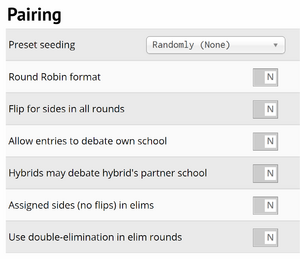
Preset seeding - Choose a method for pairing preset rounds. If you choose an option other than "Randomly," you will need to assign preset seeds to each entry.
Round Robin format - Will enable configuring of pods (if desired) and pairing the event as a round robin.
Flip for sides in all rounds - Mostly useful for Public Forum, will cause each round to be listed as flip for sides, with no constraints imposed by the pairing.
Allow entries to compete against their own school - Option to allow a school to debate each other.
Hybrids may debate hybrid's partner school - Option to allow or constrain hybrid entries from both participating schools.
Avoid in-region matchups in presets - Option to prevent same region entries from competing against one another.
No sidelocks in elims - Toggle to remove the default that all elims are flip for sides.
Side-lock all elims - Toggle to remove judges' ability to change debate sides on their online ballots. This does not randomly assign sides.
Use double-elimination in elim rounds - Option to allow double elimination (an entry has to lose twice) before they are eliminated from the tournament.
Judges
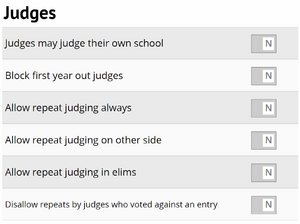
Judges may judge their own school - Generally not recommended, but can be useful in very tight judging situations or when one school is much larger than all the other schools in the field.
Block first year out judges - Will prevent first year out judges from being entered in a tournament.
Allow repeat judging always - Will allow a judge to judge an entry an indefinite number of times regardless of whether it is a preliminary or elimination round.
Allow repeat judging on opposite side in prelims - Will allow a judge to judge the same entry if they are on the opposite side during the prelims.
Allow repeat judging in elims/finals - Will allow judges to judge the same entry in elimination rounds an indefinite number of times.
Auto-bye debates without sufficient judging - Debates without a judge will receive a bye.
Powermatch
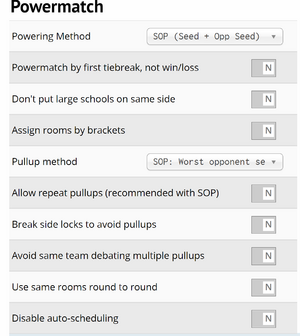
Powering Method - All powermatching is done based on the Tiebreak rules you set in Settings - Rules & Results, but this option lets you choose whether powermatching should use the "SOP" method, or only the entry's seed. SOP uses a combination of the entry's seed and their prior opponent's current seed, which helps to create a more "balanced" draw for each team. SOP has emerged as the standard for powermatching - unless you're sure what you're doing, it's recommended you leave the default.
Powermatch by first tiebreak, not win/loss - Toggle to power match based primarily off a determined tiebreaker instead of the win-loss record of the entries.
Don't put large schools on same side - Toggle to prevent large schools from being on the same side of the bracket. Large schools in this sense are those with a lot of entries in a particular event.
Assign rooms by brackets - Toggle to have auto-assign room functions work by brackets, which can help keep teams of similar records in the same set of rooms, minimizing the distance people have to move. If you use this option in concert with assigning room "quality" ratings, it can help put the higher win brackets in better rooms, while relegating the lowest-win brackets to your worst rooms.
Pullup method - Choose a method for determining which entry gets pulled up to a higher win bracket. It's recommended that you stick with the default, which is "Worst average opponent seed," unless you know exactly what you're doing.
Allow repeat pullups (recommended with SOP) - This option is recommended if you're using the default SOP powermatching method above, since it can help even out the difficulty of a team's draw.
Break side locks to avoid pullups - This option will try as hard as possible to avoid pulling a team up to a higher win bracket, even if it means breaking side locks and having them debate on the same side more than half the time. Most tournaments shouldn't use this.
Avoid same team debating multiple pullups - Toggle to prevent a team debating from getting pullups multiple times in a tournament.
Disable auto-scheduling - Toggle to prevent a round from being auto-paired once results from the previous round are in.
Web Publishing
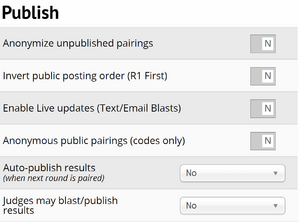
Auto-generate share.tabroom.com rooms - Toggle to enable document sharing in the NSDA Campus rooms.
Anonymize unpublished pairings - Option to hide school and names from the tournament staff creating the pairings.
Show section letters on schematics - Option to include section letters on the public schematic, if you choose to use sections in particular events.
Invert public posting order (R1 First) - Option to put the oldest pairing first and the newest pairing last in the Tabroom display.
Enable Live updates (Notifications & Email Blasts) - Option to allow notifications and email blasts when pairings are published for an event.
Anonymous public pairings (codes only) - Option to only use entry codes on public pairings rather than team or individual names.
Auto-publish results - Option to have results automatically publish when the pairing for the next round is posted.
Judges may blast/publish results - Option to allow judges to publicly post the result of a round after they announce it.
Tabulation
Input
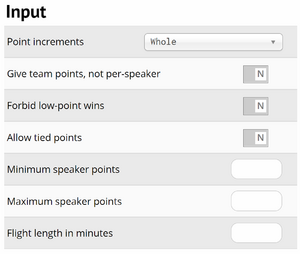
Point increments - Choose whether to use Whole, Half, Quarter, or Tenth points for speakers.
Give team points, not per-speaker - Option to assign points by whole teams instead of individual speakers.
Forbid low-point wins - Option to prevent a judge from assigning more speaker points to the losing team.
Allow tied points - Allow judges to give the same number of speaker points to multiple participants in the same round.
Minimum speaker points - Sets a floor for how many speaker points a judge can assign.
Maximum speaker points - Sets a ceiling for how many speaker points a judge can assign.
Flight length in minutes - Sets a time limit for flighted events.
Output
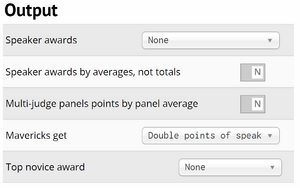
Speaker award tiebreakers - Determines the set of values used to determine speaker awards.
Speaker awards by averages, not totals - Option to allow to use an average of competitors' speaker points to determine awards rather than their total points.
Multi-judge panels points by panel average - Option when using panels of judges to take the average speaker points as one score instead of a participant receiving multiple scores from a round.
Mavericks points - Determines how speaker points function for maverick competitors.
Top novice award - Option to determine the top novice award in an event. You can choose to give this award based on overall novice participants or from those not advancing to elims.
Online Ballot Options

Use Online Ballots - When enabled, this will allow judges to link their tabroom account to their judge entry at the tournament and complete their ballots online, rather than needing the tabroom to distribute, collect, and enter ballots.
Use Online Coinflips - Option to utilize Tabroom's online coinflip settings.
RFD Minimum word count - Sets a floor for how many words a judge has to write in their Reason for Decision.
Default Timer Speech Time - Sets the speech times used in the display timers after a judge opens their online ballot.
Timer Default Prep Time - Sets the prep times used in the display timers after a judge opens their online ballot.
Decision Deadline (minutes post start) - Sets the deadline for when a judge has to make a decision.
Elim Decision Deadline - Sets the deadline for when a judge has to make a decision in an elimination round (usually longer than a preliminary round).
Hide panel decisions from judges - Option to prevent judges from seeing the final result of a panel judged debate.
Hide final round decision from judges - Option to prevent judges, on a final round panel, from seeing the result of that final.
Start Button Label - Text you want judges to see on the start button. We recommend 'Start Round,' however; use whatever works for your tournament.
Start Instructions - Text that you want to appear above the start button.
Ballot & Rules

Affirmative designation - Option to label the side that will be Affirmative in rounds (can choose Aff, Pro, Prop, etc).
Negative designation - Option to label the side that will be Negative in rounds (can choose Neg, Con, Opp, etc).
Topic - Displays the topic for the event on the ballot.
Combo ballots (All flights on 1 page) - Toggle to use combo ballots for an event.
Big Questions ballots - If you have BQ at your tournament, toggle to use a BQ-specific ballot for that event.
Ballot Boxes
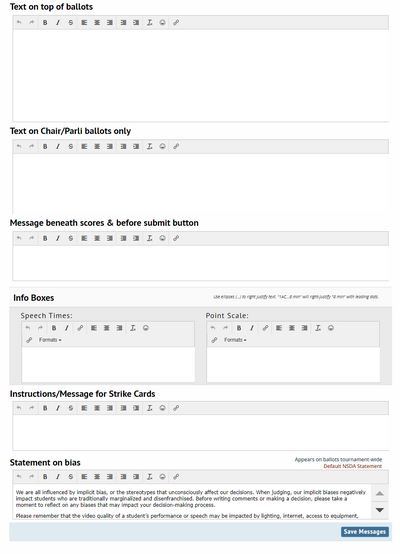
Text on top of ballots - Message displayed on the top of ballots.
Text on Chair/Parli ballots only - Messaged displayed on panel chairs and parliamentarian ballots.
Message beneath scores & before submit button - Message displayed before judges finally submit their ballots.
Info Boxes - Reminder boxes that will display to judges. These should be used to display speech times and a standard speaker point scale for your event.
Instructions/Message for Strike Cards - Instructions given to participants on how to fill out strike cards.
Statement on bias - Message displayed at the top of ballots related to judge biases. This is a tournament-wide message and will be shown on all ballots.
Updates
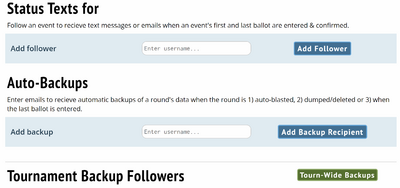
Status Texts - Option for tab staff to receive updates when the first and last ballot of an event are entered.
Auto-Backups - Option to send backup data to certain emails.
Tournament Backup Followers - Option to add a person to receive all backup data for your tournament. This can be the same person receiving auto-backups or someone completely different.